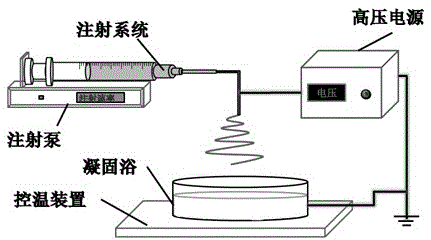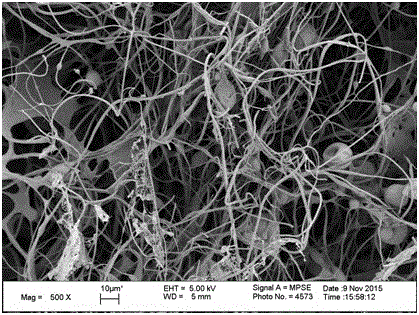Nanofiber tissue filler and preparing method thereof
A nanofiber and filler technology, applied in medical science, surgery, etc., can solve the problems of difficult infiltration of scaffolds by tissue fluid, difficult to support, easy to deform, etc.
- Summary
- Abstract
- Description
- Claims
- Application Information
AI Technical Summary
Problems solved by technology
Method used
Image
Examples
Embodiment 1
[0055] S1. Add 0.8g of polylactic acid into 10ml of hexafluoroisopropanol solution, stir at room temperature until dissolved, and make 8% (w / v) spinning solution; add 10g of gelatin into 100ml of deionized water, heat to 40 Stir until dissolved at ℃ to make a 10% (w / v) treatment solution; add 500ml of absolute ethanol to the crystallization dish and heat to 55℃ as a coagulation bath;
[0056] S2. If figure 1 As shown, add the spinning solution into the syringe, add an extension tube to the front end of the syringe and connect a 20G needle, place the syringe on the micro-injection pump, the needle is perpendicular to the crystallization dish, and the lower part of the crystallization dish is grounded; set the injection rate to 2ml / h, When the solution is extruded from the needle tip, a voltage of 18kv is applied to the needle tip; at this time, nanofibers are ejected and collected in the coagulation bath; when the collected nanofiber cluster reaches a certain amount, the voltag...
Embodiment 2
[0062] S1. Add 0.6g of polycaprolactone into 10ml of hexafluoroisopropanol solution, stir at room temperature until dissolved to make a 6% (w / v) spinning solution; add 1g of hyaluronic acid into 100ml of deionized water , stir until dissolved, then add 2g of antibiotic ceftriaxone sodium powder to the treatment solution to make a treatment solution with a hyaluronic acid concentration of 1% (w / v) and a ceftriaxone sodium concentration of 20mg / ml; 500ml of absolute ethanol Add it to a crystallization dish and heat it to 55°C as a coagulation bath;
[0063] S2. If figure 1 As shown, add the spinning solution into the syringe, add an extension tube to the front end of the syringe and connect a 20G needle, place the syringe on the micro-injection pump, the needle is perpendicular to the crystallization dish, and the lower part of the crystallization dish is grounded; set the injection rate to 3ml / h, When the solution is extruded from the needle tip, a voltage of 20kv is applied t...
Embodiment 3
[0068] S1. Add 0.8g of polylactic acid into 10ml of hexafluoroisopropanol solution, stir at room temperature until dissolved, and make 8% (w / v) spinning solution; add 10g of gelatin into 100ml of deionized water, heat to 40 Stir at ℃ until dissolved, then dissolve 1g of sodium alginate in the above treatment solution, the concentration of gelatin in the final treatment solution is 10% (w / v), the concentration of sodium alginate is 1% (w / v); 5g Calcium chloride was dissolved in 95ml of deionized water to make a gel solution; 500ml of absolute ethanol was added to the crystallization dish and heated to 55°C as a coagulation bath;
[0069] S2. If figure 1 As shown, add the spinning solution into the syringe, add an extension tube to the front end of the syringe and connect a 20G needle, place the syringe on the micro-injection pump, the needle is perpendicular to the crystallization dish, and the lower part of the crystallization dish is grounded; set the injection rate to 2ml / h,...
PUM
| Property | Measurement | Unit |
|---|---|---|
| diameter | aaaaa | aaaaa |
| diameter | aaaaa | aaaaa |
| density | aaaaa | aaaaa |
Abstract
Description
Claims
Application Information
 Login to View More
Login to View More - R&D
- Intellectual Property
- Life Sciences
- Materials
- Tech Scout
- Unparalleled Data Quality
- Higher Quality Content
- 60% Fewer Hallucinations
Browse by: Latest US Patents, China's latest patents, Technical Efficacy Thesaurus, Application Domain, Technology Topic, Popular Technical Reports.
© 2025 PatSnap. All rights reserved.Legal|Privacy policy|Modern Slavery Act Transparency Statement|Sitemap|About US| Contact US: help@patsnap.com



